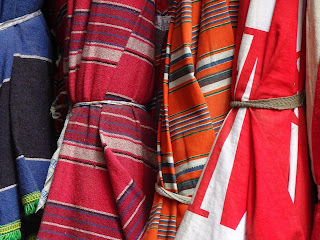 |
| Need a Camel Saddle? |
No visit to Cairo is complete without a
trip to the Khan. Originally built to house makers and sellers of
luxury goods it provided a secure indoor location for these merchants
to sell their products. Now it is mostly taken over by tourist shops,
but careful exploring will yield some of the original craftsmen and
merchants. This was our second visit to this fascinating market, and
we enjoyed it as much this time as in 2009 when we first visited.
We started exploring out on the streets
surrounding the Khan, wandering by shops selling camel saddles,
wooden buckets, kitchen tools and numerous other specialities. We
went to the Tentmaker's Alley where tents were originally made and
decorated, and you can still order an elaborate custom made tent to
provide shelter when desert camping, but this area is also slowly
being taken over by the tourist shops. We walked by shops selling
full coverage women's gowns still common here in Egypt, in any colour
so long as it was black, right next to vivid displays or bras and
skimpy underwear in every day-glow colour imaginable. Each of these
streets surrounding the Khan, has little side alleys tempting you to
wander off down to see what they had hidden.
 |
| Tents in any colour . . . |
When you finally enter the Khan itself,
you are inside a massive building with ceilings and multi levels
where merchants originally lived and worked. The shops are mostly on
the one level, but looking up reveals an entirely separate world of
windows and verandas and who knows what.
Fortunately we had our own private
guide and we were taken to many shops that were not the average
tourist-trap. We visited a custom jewellery shop where you could
order special items made to order as you waited. Down one narrow
alley/hallway we were introduced to a university professor who has
continued his father's craft of creating wonderful items from camel
bone. The shop is full to the ceiling with interesting objects carved
and created from camel bone.
 |
| Is this built to code? |
Then we went down another narrow side
alley past a shop making glassware from recycled bottles and glass,
around three or four tight corners, up various flights of stairs
twisting up, up and around until somewhere high into the upper
reaches of the Khan, we met a man who we visited last time and he
unlocked his Alabaster shop, where objects created from this stone
reached from floor to ceiling. It is impossible to leave this shop
without purchasing something. I'm just glad my guide knew the way,
because I know I could never find it again.
Be careful how you bargain with the
merchants. I saw a leather messenger bag I sort of liked and was
quoted a price of 2500 Egyptian pounds. However when I examined it
more closely I really did not like it, but because I originally
expressed interest, the merchant wanted that sale. 2000 EP . . . .
1600 EP, 1000 EP . . . . 800 EP as he followed me down the market.
Finally I said I “might be back”, and he left. Mistake, walking
back out of the Khan he was still there, bag in hand dropping the
price as I walked past. I think I could have gotten it for about
$30.00.

















































